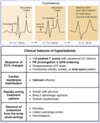Renal, Urinary Systems and Electrolytes II Flashcards
(64 cards)
What acid-base disorders are associated with aspirin (salicylate) toxicity?
[…] (early) and […] (late)
What acid-base disorders are associated with aspirin (salicylate) toxicity?
respiratory alkalosis (early) and metabolic acidosis (late)
respiratory alkalosis due to increased respiratory drive; metabolic acidosis due to increased production/decreased elimination of organic acids
What acid-base disturbance is associated with primary adrenal insufficiency (Addison disease)?
Normal anion gap metabolic acidosis
decreased aldosterone results in retention of H+
What antibiotic is associated with hyperkalemia and elevated serum creatinine?
Trimethoprim
due to blockade of epithelial Na+ channels (ENaC) in the collecting tubule; elevated creatinine is an artificial increase due to inhibition of renal creatinine secretion (GFR remains the same)
What are the most common renal pathologies (2) seen with analgesic nephropathy?
papillary necrosis and chronic tubulointerstitial nephritis
may have sterile pyuria, WBC casts, microscopic hematuria, and/or mild proteinuria on urinalysis

What BUN:creatinine ratio is suggestive of prerenal acute kidney injury?
> 20:1 BUN:creatinine

What class of anti-depressants is commonly associated with SIADH?
SSRIs
especially in elderly patients

What class of antibiotics used to treat severe gram-negative infections is potentially nephrotoxic?
Aminoglycosides
What class of drugs are useful for patients with urge incontinence?
Anti-muscarinics (e.g. oxybutynin)
first-line treatments include bladder training and pelvic floor muscle exercises; medical therapy is reserved for those who don’t respond

What classes of medications (2) are used for pain management in patients with kidney stones?
narcotics and NSAIDs (preferred with normal renal function)
e.g. morphine (narcotic) and ketolorac (NSAID)
What complication may result from correcting hypernatremia too quickly?
Cerebral edema
“high to low, your brain will blow”
What complication may result from correcting hyponatremia too quickly?
Osmotic demyelination syndrome (central pontine myelinolysis)
“low to high, your pons will die”
What does a positive leukocyte esterase on urine dipstick indicate?
Significant pyuria
What does positive nitrites on urine dipstick indicate?
Gram negative bacteria
What drug class is useful for the management of recurrent nephrolithiasis secondary to idiopathic hypercalciuria?
Thiazide diuretics
other preventive measures include increased fluid intake and a low Na+/protein diet

What drug should be discontinued in an acutely ill patient with sepsis and acute renal failure taking low-dose aspirin, atorvastatin, metformin, and sitagliptin?
Metformin
nephrotoxins, such as NSAIDs and metformin, should NOT be given to patients with acute renal failure or sepsis; low-dose aspirin has not been shown to precipitate or worsen renal failure
What effect does intracellular magnesium have on renal K+ secretion?
Decreased K+ secretion
via inhibition of renal outer medullary potassium (ROMK) channels
What formula is used to calculate the anion gap in patients with metabolic acidosis?
AG = (Na+) - (HCO3- + Cl-)
should be calculated in all patients with metabolic acidosis to narrow the differential
What formula is used to calculate the osmolal gap?
measured serum osmolality - calculated serum osmolality

What formula is used to calculate the serum osmolality?
the normal osmolal gap (measured - calculated) is < 10

What hematologic laboratory values are consistent with abnormal hemostasis due to chronic renal failure?
PT: […]
PTT: […]
Platelet count: […]
Bleeding time: […]
What hematologic laboratory values are consistent with abnormal hemostasis due to chronic renal failure?
PT: Normal
PTT: Normal
Platelet count: Normal
Bleeding time: Prolonged
underlying cause is platelet dysfunction
What imaging modalities (2) are preferred for detecting kidney stones?
CT scan of the abdomen without contrast (preferred) or ultrasound
high sensitivity and specificity; also can detect radiolucent stones, which are missed on abdominal X-ray
What imaging modality is preferred for diagnosis of renal cell carcinoma?
CT scan of the abdomen

What is recommended treatment for an acute rejection of a renal transplant?
IV steroids
What is the best test to screen for the initial stages of diabetic nephropathy?
Urine test for microalbumin:creatinine ratio
either spot or timed urine collection; dipsticks only detect excess urinary protein when > 300mg/24hr (macroalbuminuria) and thus are not useful for screening























